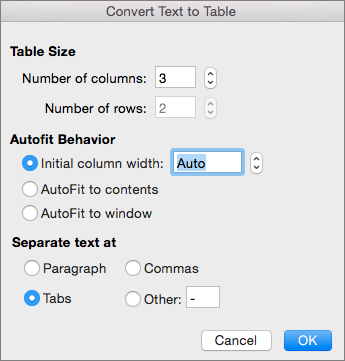How Do I Add A Column To A Table In Word For Mac
02.01.2019by admin
If you're using Word to present a table of data that includes numbers, you can use Word's built in formulas to add up those numbers rather than manually calculate them each time they change. This can also eliminate the possibility of error - particularly important if you're producing a sales proposal or an important report. Note that you can't just add up numbers on different lines - you can only add up numbers that are presented in either a column or a row inside a table. First, create your table and decide which column or row will hold the numbers you wish to add up. Enter the numbers, making sure that there is a number in each cell in the column.
Then, in the last row in the table, click in the cell in the number column and choose Insert > Quick Parts > Field, then click Formula A new dialog box should appear containing a Formula field with one of the following formulas: =SUM(ABOVE) =SUM(LEFT) Note - if you get an error rather than one of these formula, it most likely means that Word couldn't find any numbers in the cells above or to the left of the current cell. You can now choose a format for the number. The list of available number format is somewhat limited, but you can manually enter any format that is supported by Excel. For example, the following format is not listed but will work to format the number with a $ sign, thousand separators and two decimal places: $#,###.## Once you've chosen a format, you can click OK. This will insert the SUM formula into the cell. Word will then calculate the sum of all the cells above the cell where the formula is located provided they all contain numbers. If you find that Word does not calculate the sum of all the numbers in the column, it is possible that one of the cells does not contain a valid number.

At the point you wish to change to two columns, Insert > Columns and then in the Layout Inspector, select the number of columns.After the insertion point, you will also need to insert another Column Change to return the following paragraphs to single column. Place the cursor where you want to place the table. Click the Insert Table icon on the Tables and Borders toolbar at the top of the window. [Drag the corner of the table until you have the desired number of columns and rows. To remove the table, select it and click Convert To Text in the Data group on the contextual Layout tab. Word will remove the table and its format, leaving the text in its original list form.
This gives rise to two possibilities: • Word will ignore any cells containing non-numbers (i.e. Text) in the column above and add up the rest of the cells. In some cases, you may have typed a number which Word sees as text instead.
Try retyping these numbers to see if that fixes the problem. • Word encounters an empty cell. Once it hits an empty cell, Word stops calculating. Any cells above the empty cell will be ignored. If this happens, you may need to rearrange the order of the rows in the table, or consider putting a text value into the empty cells. We welcome your comments and questions about this lesson.
Free download microsoft office 2011 for mac with product key. All of these programs come with Mac compatibility and are available for instant download at Software Keep’s competitive prices.
We don't welcome spam. Our readers get a lot of value out of the comments and answers on our lessons and spam hurts that experience.
Our spam filter is pretty good at stopping bots from posting spam, and our admins are quick to delete spam that does get through. We know that bots don't read messages like this, but there are people out there who manually post spam. I repeat - we delete all spam, and if we see repeated posts from a given IP address, we'll block the IP address. So don't waste your time, or ours.
How Do I Add A Column To A Table In Word For Mac
Thanks for pointing this out. You're right that the numbers won't update automatically. You can update a total by right-clicking the total and choosing the Update Field option. If you have multiple total fields (or other types of Word fields, such as a table of contents or cross references to other parts of your document) you can trick Word into recalculating all of them by pressing CTRL+P (or simply choosing the Print option). You don't actually have to print the document, but this will force Word to recalculate the fields in your document. Submitted by Visitor on Tue, - 08:24.
I’ll admit it — I’m not a big fan of the Columns feature in Microsoft Word. Not that there’s anything wrong with it, per se. It works fine (until ). But in a legal office environment, I usually format blocks of information with because they’re a bit easier to control.
But I’ve seen lots of legal professionals use columns to format things like service lists in Certificates of Service. Hey, to each her [his] own. So if you want to use this feature in your Microsoft Word documents, here’s what you need to know: Inserting Columns: The Basic Primer Everything starts from the Format menu in 2002 and 2003: In Word 2007 and 2010, this feature has been moved to the Page Layout Ribbon under Page Setup (the rest of the steps are the same in all versions): Once you click on that, you’re taken to a dialog box that allows you to set up your columns the way you want them. The default is one column — just a regular document.